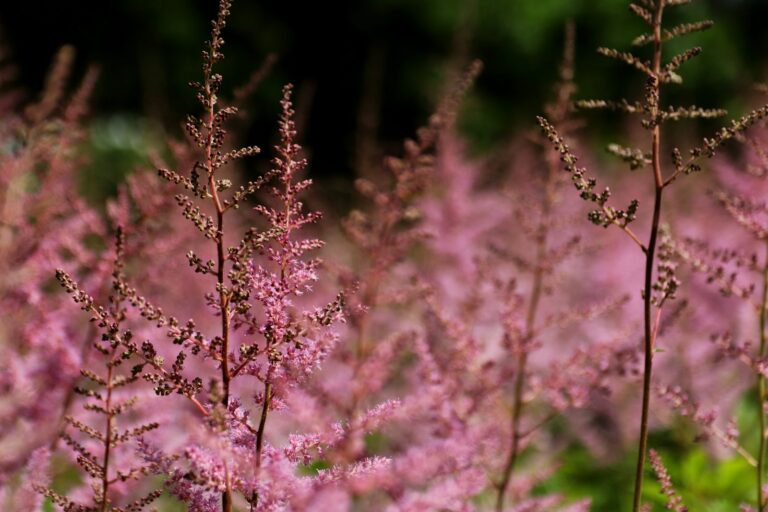Deer Resistant Astilbe: Protection from Wildlife Damage
Your astilbe produces vibrant plumes while neighboring hostas get stripped to bare stems. The difference lies in natural deterrents that wildlife avoid. Astilbe features fuzzy leaf texture and unpalatable taste that deer and rabbits typically bypass[1][2]. This resistance protects your shade garden investment.
Understanding Astilbe’s Natural Deer Resistance
As a food source, deer and rabbits seldom seek astilbe. Astilbe is rated Seldom Severely Damaged by Rutgers University on their deer resistance scale and therefore rated the second-best option for vegetation that is susceptible to grazing by wildlife[1]. In contrast, no plant provides complete immunity from ravenous animals and astilbe still holds one of the most viable options for a garden under continuous deer pressure.
The fuzzy feel of the astilbe leaves is a huge inhibitor. Deer and rabbits like easy-to-love leaves while rabbits like smooth, delicate leaves instead of plants with hairy or rough surfaces[3]. Astilbe leaves and stems have very fine hairs with which animals can’t easily browse due to rough and soft hair. This textural barrier operates during the entire growing season, from spring emergence to fall dormancy.
Why Wildlife Avoid Astilbe
Taste is equally vital to astilbe’s resistance. Deer as well as rabbits find some of the leaves unappetizing[2]. Unlike hostas, daylilies, and other ubiquitous shade perennials that wildlife enjoy consuming, astilbe leaves do not have the palatability to attract browsers. Animals eat the plant once and usually move on to tastier alternatives.
Astilbe’s fuzzy texture and bitter taste make it one of the most reliable deer-resistant perennials for shade gardens.
Starvation conditions impact browsing behavior. Deer will eat plants on occasion during severe winter periods in which food sources can be limited for many periods of time, and drought to some extent. Not infrequently do they find themselves eating plants they tend to avoid[1]. Astilbe can get eaten when wild animals are extremely hungry, but this occurs much less frequently than plants without natural deterrents. Under stress, astilbe is still only a minor priority when compared with truly deer-resistant options.
Vulnerability and Recovery
New plants are more vulnerable than more mature specimens. Fresh grown astilbe has tender growth with more attraction to wildlife than mature foliage. The first growing season introduces increased vigilance as plants form root systems. After the first year, natural resistance becomes more reliable[1].
It recovers relatively quickly when browse damage occurs. Its rhizomatous growth pattern ensures that astilbe plants may regenerate from underground structures despite damage to their foliage. Cut back some damaged leaves to promote new growth. In spring, you will need regular watering and a phosphorus-rich fertilizer application to promote recovery[1]. Under proper care conditions, most browsed astilbe recovers within weeks.
Astilbe Variety Selection
Several types of astilbe have equivalent resistance in common. Studies show that deer preference is not markedly altered between different cultivars[7]. No matter if you choose Chinese astilbe, Japanese astilbe, or hybrids, the wildlife avoidance in the process will be the same. Plant choices might be color-, height-, and bloom time-sensitive, rather than different resistance levels.
Companion Planting Strategies
Companion planting can serve to further protection measures. Vulnerable plants are protected by astilbe in the immediate vicinity of the plant. Hostas placed behind astilbe boundaries enjoy, indirectly at least, protection from the unpalatable perimeter[1]. This layering approach proves particularly effective in shade gardens.
Ferns mesh well with astilbe in areas prone to deer. Both plants resist browsing and prefer similar growing regimes of partial shade to full shade with consistent moisture[4]. Japanese painted fern, autumn fern, and lady fern pair well with astilbe’s feathery plumes, lending it textural interest the whole season. Zones of mass planting of these companions are learned to avoid by deer.
Additional Resistant Shade Perennials
Other resistant shade perennials expand selection options even more:
- Pulmonaria provides early spring blooms and spotted foliage that deer bypass
- Hellebores have late winter flowers with thick leathery leaves that animals avoid
- Bleeding hearts bloom, with early examples of astilbe, to produce an extended color in areas of high animal browsing[5]
- Coral bells contribute colorful foliage between clumps of astilbe
These mixed approaches are also aesthetically pleasing, and reduce risk of damage.
Ornamental grasses add structure to astilbe plantings. Varieties like Japanese forest grass tolerate shade and resist deer browsing[5]. Its texture offsets the bolder flower spires of astilbe yet has the softness and flowing naturalistic grace for the delicate shade plants that shade gardens require. Grasses also provide winter interest after astilbe goes dormant.
Bright foliage between clumps of astilbe comes from coral bells. Rustic and burgundy leaf tones add new life to the green foliage of astilbe, as well as an expansive pink–white flower palette. When both plants are in zones 4–9 they have similar moisture requirements, simplifying maintenance schedules[5]. Deer typically leave coral bells untouched due to their bitter taste.
Physical Protection Methods
Barrier strategies also provide supplementary protection during establishment. Fencing as a physical structure limits all wildlife access and requires investment and installation. Netting covers new plants to protect tender growth without permanent construction. Removing barriers is desirable when plant growth reaches maturity and natural resistance is established[1].
| Protection Method | Effectiveness | Best Use | Maintenance |
|---|---|---|---|
| Physical fencing | Very high | Long-term protection | One-time installation |
| Netting | High | Establishment period | Remove after maturity |
| Repellent sprays | Moderate | Temporary deterrence | Reapply after rain |
| Scent deterrents | Moderate | Perimeter protection | Monthly rotation |
| Motion sprinklers | Moderate-High | Access points | Battery/sensor checks |
Repellent products are an instrument of temporary deterrence. Spray applications containing dried blood, garlic oil, or egg solids create scents deer avoid[3]. You have to reapply these products after rain and throughout the growing season. Apply repellents to nearby plants and not astilbe, which already possesses natural resistance.
Alternative Deterrent Methods
Scent-based deterrents function by means of olfactory aversion. Bars of strongly scented soap draped in mesh bags near plantings repel browsers. Deer and rabbits become afraid of predators using predator urine products that trigger fear responses. These techniques are most effective when rotated with other strategies to avoid habituation. Put deterrents in garden perimeters instead of in astilbe beds[3].
Motion-activated devices trigger wildlife to wander away from plants. Sprinkler systems that activate when animals enter create negative associations with the habitat. These tools are most effective during evening and early morning hours, the times when deer are most actively browsing[3]. Position sensors to cover access points instead of individual plant groups.
Garden design matters—dense plantings of resistant species like astilbe create barriers that wildlife learn to avoid.
Garden Design and Timing
Garden design impacts wildlife traffic patterns. Deer like open sight lines to easily escape. Dense plantings of resistant plants such as astilbe act as barriers that animals avoid navigating. By clustering astilbe along property edges, we delineate boundaries that channel wildlife traffic away from vulnerable plants in the garden interior.
The timing of planting also changes for certain deer-prone areas. Spring installation allows astilbe to establish before the stress of winter tests wildlife browsing limits. In zones 5-7 where winters are mild enough for root development, fall planting works well[6]. Avoid planting during drought when competition for moisture raises animal interest in succulent growth.
Soil and Spacing Considerations
Soil preparation allows strong growth that withstands occasional browse. Use compost or leaf mold to improve moisture retention in planting areas. Astilbe needs consistent moisture during the growing season, especially when establishing[6]. Well-nourished plants recover faster after any damage.
Spacing affects both plant health and wildlife interaction. Set astilbe 16-24 inches apart to allow air circulation while creating dense coverage[4]. Tight grouping prevents deer from entering planted areas. Wide spacing opens gaps that encourage browsing and diminish the cumulative deterrent effect.
Ongoing resistance is also affected by maintenance practices. It is recommended to keep your astilbe beds mulched with 2 to 3 inches of organic material to retain moisture and suppress weeds. Remove flower stalks in late fall or leave them for winter interest without reducing deer resistance[6]. Healthy, vigorous plants have better natural defenses than stressed specimens.
Long-Term Maintenance
Division maintains plant vigor and extends coverage. Dig and separate astilbe clumps every 3-4 years in early spring or fall[6]. Transplant divisions to expand protected zones or share them with neighbors to create new, resistant plantings throughout neighborhoods. Larger collective areas of deer-resistant species condition local wildlife to look elsewhere for food.
You can use your shade gardens to combine beauty and wildlife resistance. Astilbe is a strong protector that deters through texture and taste. When combined with strategic companion plants, proper care during establishment, and supplemental barriers, astilbe forms colorful displays deer and rabbits consistently bypass. A foundation of wildlife-resistant shade gardens for long-term success will always start with astilbe.
Key Sources:
[1] Are Astilbe Deer Resistant? | Plant Addicts
[2] Deer and Rabbit Resistant Perennials | Walters Gardens, Inc.
[3] Your Guide to a Deer-Resistant Garden | Wallace’s Garden Center
[4] Growing Astilbe | Garden Design
[5] 12 Astilbe Companion Plants | The Spruce
[6] How to Grow and Care for Astilbe | Clemson HGIC
[7] Astilbe japonica | NC State Extension
Lily Morgan is a home gardener. She grows houseplants and designs small-space gardens. She shares what she learns from experience. Lily offers simple, practical tips for plant lovers. Her goal is to help others garden with confidence. She wants to help them grow, one leaf at a time.


